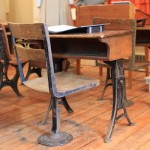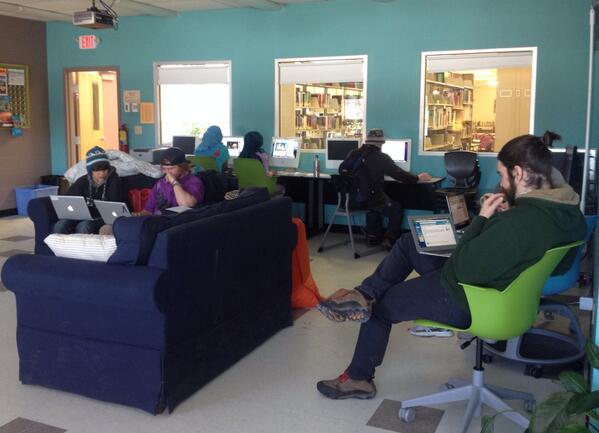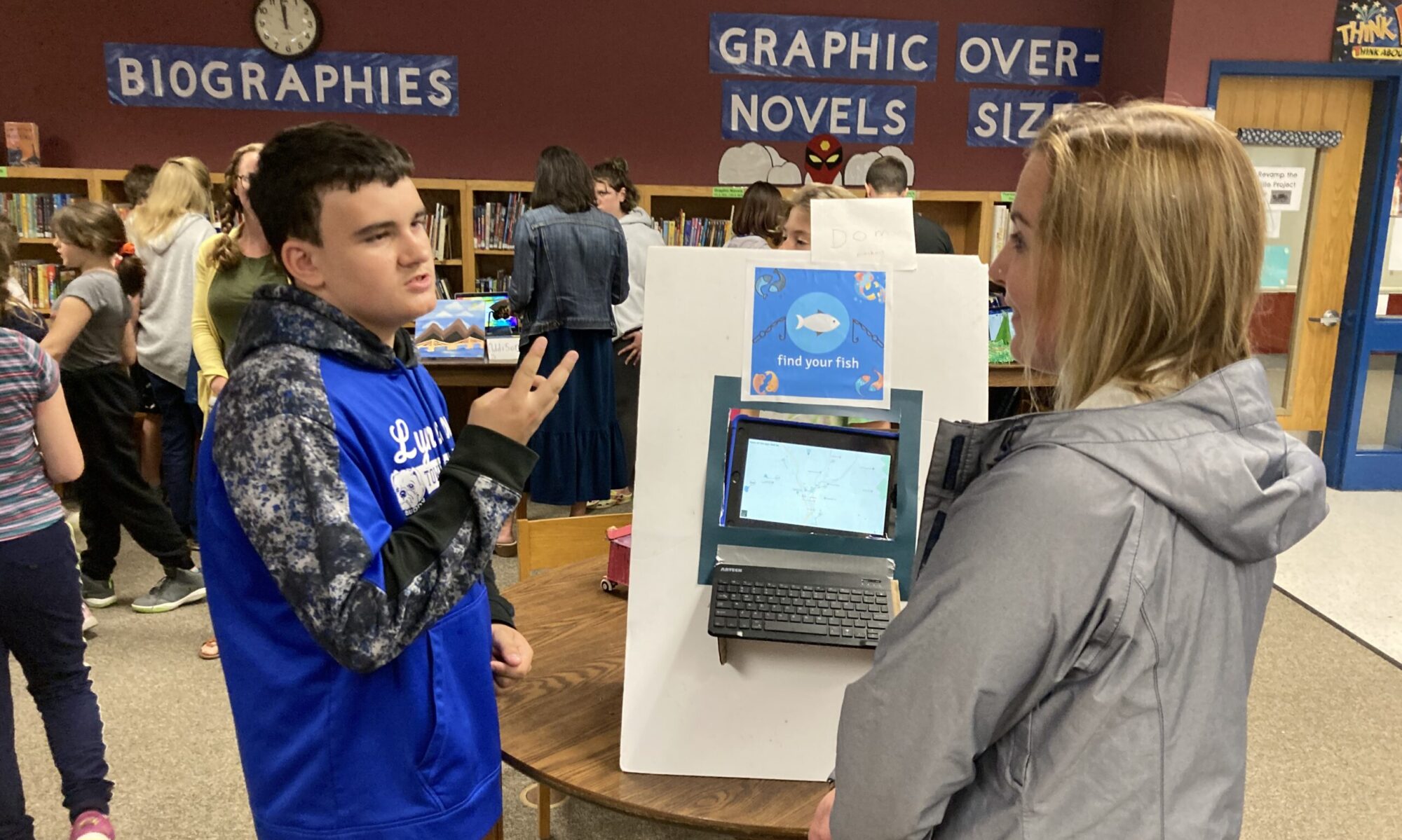Flexible learning environments have a physical component — and effect

Do you recognize the object at left?
Does it look like a comfortable learning environment for a student? Does it look like the type of learning environment a student would choose for themselves?
OF COURSE NOT, and because you are all such passionate and committed educators, you started shaking your heads the minute the image loaded. You’ve worked hard at banishing these ancient things from your rooms.
But here are some ways educators can make their physical classroom settings more flexible and responsive to student learning needs.
What does this mean for incorporating change into your classroom?
Classrooms can be transformed into flexible physical learning environments through changes to 3 things: seating, schedule and student spangle. Yes, spangle. Bear with me.
1. Seating
When you picture middle grades students learning, do you picture something like:
Winooski 5th graders are already loving reading on the 1st day!! pic.twitter.com/F1Adwekpo4
— WinooskiLearns (@WinooskiLearns) August 27, 2014
or this?
Not all things that look like seats really are (see our terrible ancient desk example at the start of this entry) aaaaand, as many students will tell you, things that don’t necessarily look like seats are actually very comfortable. Libraries tend to do this well. For instance:
Winooski 2nd graders getting comfortable in the Library Learning Commons! pic.twitter.com/rZB2qnRLMo
— WinooskiLearns (@WinooskiLearns) January 16, 2015
And also:

The iLab space at Winooski Middle School has been expressly designed to look, feel and operate very differently from a conventional classroom space. From windows looking directly onto the library, to a central collaborative couch-space and vibrant wall and chair colors, a huge amount of thought has gone into how real students use and learn with technology.
#edtech | #school | MT @mraspinall: The modern computer lab pic.twitter.com/DKIl4JavMi — Ron Perron (@rp31) October 13, 2014
The Nerdy Teacher took photos of his classroom and marked them up with Skitch and Evernote, to show how students were using — and not using different portions of the space. He used the photos to identify physical barriers between him and his students, and brainstorm ways to eliminate them and use the space more invitingly. He went and sat in some of the student desks so he’d know what his students were looking at.
But getting up and moving around isn’t just for students…
One day a week the staff gets together for an element of fun by playing a game. Nice toss @kevinhoneycutt! #fun pic.twitter.com/SdiEiy6mwb — ESSDACK (@ESSDACK) March 26, 2015
Middle school is not a building (or even a collection of buildings)
Redefine the physical boundaries of what you consider school; encourage students to attend off-campus events that further their learning goals. Have a student who’s interested in both documentary film-making and the environment? Have them contact the ECHO Lake Aquarium and Science Center about filming their next panel discussion on water quality. See how many museum experts would like to be interviewed about their areas of specialty (spoiler: all of them do). See if VCAM, the local community access media channel, has any camera operation classes or video editing equipment (spoiler: they’ve got both). Mobile devices can be helpful in this regard, as the ability for students to carry internet access around with them makes the entire world — not just school — more rife with learning opportunities. “We’re just unimaginably more connected to the world around us,” says Lilly, a student at Burlington High School (BHS), of the students’ experience with iPads. “The school becomes not just what’s inside these four walls at BHS, but what the entire community can offer us.”
Or just go outside
Sometimes outside is part of your community, like for students at Richmond Elementary School, studying the maple syruping process:
View out the back windows of @resvt today. Local sugarmakers helped our scholars tap maple trees! #cesuvt #vted pic.twitter.com/546GeShvUA — RES Library (@RESVTlibrary) April 8, 2014
Or finding inspiration in nature:
Turning tiny topics found on our observation walk into poems…excited to start our new unit! #resvt #tcrwp pic.twitter.com/WmuuWkf7QQ — RES Third Grade (@RESGrade3) March 9, 2015
Teachers, too, can benefit from a change of scenery:
A1: E mihi ana ki tēnei = Grateful for this to escape to, reflect & recharge for 2015 #whatisschool pic.twitter.com/IDFPjUw0zA — Te Mihinga Komene (@temihinga) January 15, 2015
2. Schedule
Look, you can’t runaround single-handedly changing the time the school bell rings (without occasioning a major school board brou-ha-ha) but what can you control about your students’ schedule? Know when to say when.
I challenge you today to take 60 seconds of pause. Do nothing but breathe. Report back here when you’re done. — ThisisVT. (@THISISVT) November 21, 2014
Get up! Move around! Shake that classroom to the ground
Brain breaks. Students really need them and let’s be honest, you do too. Just standing up and shaking it all out or even just standing up can reset the whole tone of an activity or a class discussion. But really, why just stand when you can dance:
Our Just Dance brain break. Got to get it movein’! pic.twitter.com/idVeIj5qiG — Laura Botte (@NiaLearns) March 5, 2015
But what about the learning, you ask? Have students be the learning!
Acting using only movement with no voice. #resvt #cesuvt pic.twitter.com/rEiE98y1Pf
— RES Third Grade (@RESGrade3) March 5, 2015
Running in the hallway! Playing Red Light/Green Light to demo Newton’s First Law #emsvt #bsdvt @JourneyLearns pic.twitter.com/iNIvHNqUZl — Laura Botte (@NiaLearns) January 28, 2015
Going to be very unusual day tomorrow with @JourneyLearns #piyoga #darnpidaywassaturday #bsdvt #emsvt pic.twitter.com/pqzF0JNjPc
— Laura Botte (@NiaLearns) March 15, 2015
Flipped classroom = learning availability outside of school hours
Encourage students to embrace their own personal peak hours of learning by making flipping your classroom and making lesson resources available online. Online is a 24/7 space, so a student who might not be at their best at 2:30 in the afternoon might head home, nap and bounce right back after dinner. Or after three episodes of America’s Next Top Model.
Respect students’ other commitments
Vermont educator Alex Shevrin wrote an incredible post about equity issues in offering extra credit, and the point she’s making holds true for this idea of schedule flexibility as well. Not every student will be able to find hours outside of the school day for work, so what does it look like to accommodate their learning times within that day? This student from Edmunds Middle School makes some great points about being able to take home a school-issued Chromebook and how it changes the after-school landscape:
3. Student SPANGLE.
Here’s the issue with those mass-produced learning objectives posters: they’re made by adults. Now, when your students’ attention spans wander (I know, I know, they hang on your every word as an educator but bear with me) and they look around the classroom, what do they see? Do they see representations of themselves? Do they see themselves and their peers as creators of their own learning and destiny? Do they see student work? At Winooski High School, students see this:
Winooski HS students map themselves and their interests to help determine iLab projects. pic.twitter.com/NoK5r1qteF — WinooskiLearns (@WinooskiLearns) September 9, 2014
Then they see the finished products — giant personalized mind-maps — all over the walls. At The Cabot School, in Cabot, VT, students in one science classroom see this blackboard wall covered with their own research notes and ideas:
New student #science #design wall is filling up with projects and ideas. #deeperlearning #PBLChat pic.twitter.com/66wJYHgC9k — Cabot Science (@CabotScience) September 20, 2014
Students at Edmunds Middle School see (and make) this:
Now is the time for courageous conversations. How do you feel about race – in 6 words. #racecardproject #bsdvt #emsvt pic.twitter.com/HthIfUkM36 — Laura Botte (@NiaLearns) January 23, 2015
Why not create beautiful space through #science & #PBL? #APES #scichat #edchat #LED #pblchat #energyefficiency pic.twitter.com/mYf9NAqHjU
— Cabot Science (@CabotScience) September 24, 2014
But let’s not burn all the desks just yet
After all, where would the Rube Goldberg machines sit?
Progress being made on Rube Goldberg Machines! #RG209 pic.twitter.com/7hbtpSlGPO — Ryan Becker (@Physci8) May 13, 2014
Want to read more about flexible physical learning environments?
- A Place for Learning: the Physical Environment of Classrooms
- Developing a dynamic learning environment
- Classroom Cribs Challenge asks teachers to rethink their learning spaces
- A new twist on concentration: standing while you work
- Creating wow-worthy learning spaces


Hack your classroom: flexible physical learning environments, featuring Vermont classrooms http://t.co/rdxzY79F43 @ThisIsVT #vted
Hack your classroom: flexible physical learning environments http://t.co/HTqfiDqx4u #vted #anesuvt
MT @innovativeEd: Hack your classroom: flexible physical learning environments, Feat VT clsrms http://t.co/mJ7eW7VW9J @THISISVT #vted #wsdvt
A good idea for al learners: Hack your classroom: flexible physical learning environments http://t.co/RqN3z6mUQS via @innovativeEd
RT @innovativeEd: Hack your classroom: flexible physical learning environments, featuring Vermont classrooms http://t.co/rdxzY79F43 @ThisIs…
Hack your classroom: flexible physical learning environments http://t.co/MbkKYSInKu
RT @innovativeEd: Hack your classroom: flexible physical learning environments, featuring Vermont classrooms http://t.co/rdxzY79F43 @ThisIs…
For the p.m: hack yr classrm: flexible physical learning spaces w/@CabotScience, @NiaLearns, @resvt, @WinooskiLearns http://t.co/ZMTjUMfSCN
RT @innovativeEd: For the p.m: hack yr classrm: flexible physical learning spaces w/@CabotScience, @NiaLearns, @resvt, @WinooskiLearns http…
“Hack your classroom: flexible physical learning environments” http://t.co/CStU2y09D7 #education #feedly #vted #vsla #tlchat
RT @innovativeEd: For the p.m: hack yr classrm: flexible physical learning spaces w/@CabotScience, @NiaLearns, @resvt, @WinooskiLearns http…
RT @innovativeEd: For the p.m: hack yr classrm: flexible physical learning spaces w/@CabotScience, @NiaLearns, @resvt, @WinooskiLearns http…
Hack your classroom: flexible physical learning environments http://t.co/OC9g6CbdPz
Hack your classroom: flexible physical learning environments
http://t.co/tPXtbr28Lh
Hack your classroom: flexible physical learning environments
#learning spaces http://t.co/Fgy1QCRAPx
Hack your classroom: flexible physical learning environments http://t.co/FAMVTryI2V
RT @kevindeforge: Hack your classroom: flexible physical learning environments
#learning spaces http://t.co/Fgy1QCRAPx
Hack your classroom: flexible physical learning environments http://t.co/fZXIVT7FiW
RT @fwheels: Hack your classroom: flexible physical learning environments http://t.co/FAMVTryI2V
Hack your classroom: flexible physical learning environments Love these ideas – we need to do this @Clark stownsouth http://t.co/VNtM1ibDyy
“@PJjHeath: Hack your classroom: flexible physical learning environments http://t.co/wokr1XlABD” @carolynarhodes @DeniceScala
RT @SueFloro: “@PJjHeath: Hack your classroom: flexible physical learning environments http://t.co/wokr1XlABD” @carolynarhodes @DeniceScala
Hack your classroom: flexible physical learning environments http://t.co/lO74GpsMD9
RT @SueFloro: “@PJjHeath: Hack your classroom: flexible physical learning environments http://t.co/wokr1XlABD” @carolynarhodes @DeniceScala
RT @innovativeEd: Hack your classroom: flexible physical learning environments, featuring Vermont classrooms http://t.co/rdxzY79F43 @ThisIs…
Hack your classroom: flexible physical learning environments http://t.co/EQFd9Ee73S
RT @SueFloro: “@PJjHeath: Hack your classroom: flexible physical learning environments http://t.co/wokr1XlABD” @carolynarhodes @DeniceScala
RT @SueFloro: “@PJjHeath: Hack your classroom: flexible physical learning environments http://t.co/wokr1XlABD” @carolynarhodes @DeniceScala
RT @s_harper3: Hack your classroom: flexible physical learning environments http://t.co/EQFd9Ee73S
Great post ! Hack your classroom: flexible physical learning environments http://t.co/8uEWmX6Wgr via @innovativeEd #tcdsb21c #edchat
RT @s_harper3: Hack your classroom: flexible physical learning environments http://t.co/EQFd9Ee73S
RT @geofduncan: Hack your classroom: flexible physical learning environments http://t.co/lO74GpsMD9
Hack your classroom: flexible physical learning environments
#wmmschat @windsormillms http://t.co/iNBQnjUCNR
Hack your classroom: flexible physical learning environments http://t.co/BVqZGQt57G
Fantastic ideas from Twitter on creating a flexible learning environment: http://t.co/PVn2Y8qKn8 @innovativeEd #edchat #5thchat
The Tarrant Institute at UVM mentioned our “flexible learning spaces…check it out! http://t.co/Sfchkgo8Ae #resvt
RT @RESGrade3: The Tarrant Institute at UVM mentioned our “flexible learning spaces…check it out! http://t.co/Sfchkgo8Ae #resvt
RT @innovativeEd: Hack your classroom: flexible physical learning environments, featuring Vermont classrooms http://t.co/rdxzY79F43 @ThisIs…